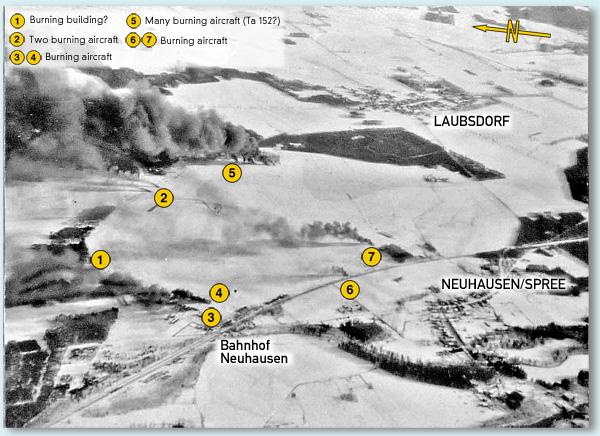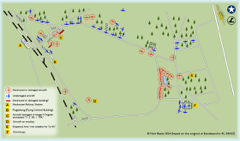|
Nehausen, Cottbus District: Strafing of airfield. One hangar with 25 aircraft totally destroyed, one person wounded. Chief of Order Police, Situation Report No. 1.340 (17 January 1945) On 16 January 1945 the US 8th Air Force was due to raid a variety of targets in Germany including the synthetic oil plants Magdeburg/Rothensee and Ruhland; Alt-Lönnewitz aerodrome (where Arado 234s were built and their pilots trained) as well as factories at Dessau and Muldenstein. In the event, the weather was so poor that three primaries were under low 10/10 cloud and secondary targets in and around Magdeburg and Dresden were bombed instead, both visually and by H2X radar. No results could be seen from attacks on the I.G. Farben plant at Bitterfeld or marshalling yards at Dessau. Alt-Lönnewitz could not be found and there was no aerial opposition although 25 enemy aircraft were claimed on the ground. The Debden-based 4th Fighter Group’s part in the day’s operations was “penetration–target–withdrawal support” for the four B-24 Combat Wings assigned to Ruhland, roughly midway between Dresden and Cottbus. At 1230 (GMT+1) the 15 P-51 Ds of the 336th Fighter Squadron spotted 35–40 aircraft on the Focke-Wulf factory airfield at Neuhausen, about 10 km south east of Cottbus. They strafed, claiming 27-0-6, and photographs showed 11 plumes of smoke rising into the sky, one of which was thought to be a burning Ju 88. They had unknowingly struck a telling blow against one of the Luftwaffe’s newest types.
Herr Vogt, acting head of the RLM’s Cottbus construction inspectorate (Bauaufsichtsleitung or BAL) reported the the attack as coming out of a cloudless sky and lasting from 12.03–12.35: The airfield was overflown from west to east at 500 m without any firing. Then the attack ensued from the north east and south west and afterward in a changing sequence from south to north and west to east, in part from as low as 3 m off the ground. The attack unfolded in about four waves of about 10 planes on the machines camouflaged on the perimeter and dispersed in the woods. A makeshift defence had been mounted by “the Luftwaffe unit based there” (see below), employing a 2 cm cannon and 10 MG 81Z twin machine guns but they could not prevent the burning-out of a small wooden hangar housing work benches, a battery charging station and transformer(s). Not only that but no fewer than 14 Ta 152s were completely destroyed along with an Fw 190 while another Ta 152 was about 30% damaged. Such a setback clearly demanded an explanation and Vogt went on to elaborate that the planes destroyed had been dispersed right up against the perimeter and concealed either with pine branches or camouflage netting. Neuhausen’s dispersal pens could accommodate the Fw 190 but not the Ta 152 on account of the latter’s greater wingspan. The planes could not be more widely spread out because the base was being shared with SG 151.
continued on next page …
|
||||||
PART ONE OF TWO The effects of the attack on Neuhausen were meticulously recorded in a hand-drawn plan which is on file at the Bundesarchiv. Unfortunately this plan has twelve holes punched through it and it is badly stained by liquid. Any coloured inks used have faded badly so annotations of damage precentages are rarely clear and although the key to the plan suggests that different symbols are used for Ta 152s and Fw 190s, in practice these are difficult to distinguish with any confidence. My interpretation below (click to enlarge) is therefore simplified to distinguish damaged and undamaged machines but I infer that most of the Ta 152s were probably in the dense cluster of damaged aircraft on the eastern side of the airfield. |
||||||
© Nick Beale 2024 |
||||||



